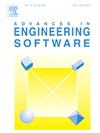A multi-objective function for discrete topology optimization in labyrinth seal design problems
IF 5.7
2区 工程技术
Q2 COMPUTER SCIENCE, INTERDISCIPLINARY APPLICATIONS
引用次数: 0
Abstract
Labyrinth seals are commonly used in sealing mechanisms to separate regions with different pressures and minimize leakage along their intricate fluid paths. In this paper, topology optimization is applied to labyrinth seal design via a novel multi-objective expression combining forward and backward flows. However, the traditional strategy is susceptible to the bad local minimum of fluid inlet/outlet closure and the absence of interlaced labyrinth-like solid regions in the final design. The aim is to provide a solution to both issues. In our approach, the labyrinth seal objective is defined by combining fluid flow energy dissipation with vorticity magnitude to design the flow path that should be favored in one direction (forward) while unfavored in the opposite direction (backward). Therefore, we address the optimization problem in the form of simultaneous minimization of forward energy dissipation while maximizing backward vorticity. Volume fraction is assumed as the optimization constraint. The Topology Optimization of Binary Structures (TOBS) method is used to solve the optimization problem. This is a gradient-based method that produces a sequence of linearly approximated problems and solves them via integer linear programming. The steady Navier–Stokes equations govern the fluid motion with the standard Darcy term used for topology optimization. It is demonstrated that the porous material model favors solutions with labyrinths of radial interlacing teeth for higher porosity values and axial interlacing topologies for lower values. Numerical examples are presented for two-dimensional prismatic and axisymmetric problems with real CO gas properties.
迷宫密封设计问题离散拓扑优化的多目标函数
迷宫密封通常用于密封机构,以分离不同压力的区域,并尽量减少沿其复杂的流体路径泄漏。本文将拓扑优化方法应用于迷宫密封设计中,提出了一种结合前向流动和后向流动的新型多目标表达式。然而,在最终设计中,传统的策略容易受到流体入口/出口关闭的局部最小值较差和缺乏交错迷宫状固体区域的影响。其目的是为这两个问题提供一个解决方案。在我们的方法中,通过结合流体流动能量耗散和涡量大小来定义迷宫密封目标,从而设计一个方向(向前)有利而相反方向(向后)不利的流动路径。因此,我们以最小化前向能量耗散和最大化后向涡度的同时形式来解决优化问题。以体积分数为优化约束条件。采用二元结构拓扑优化(TOBS)方法求解优化问题。这是一种基于梯度的方法,它产生一系列线性逼近问题,并通过整数线性规划来解决它们。稳定的Navier-Stokes方程用用于拓扑优化的标准Darcy项来控制流体运动。结果表明,多孔材料模型倾向于具有高孔隙率和低孔隙率的径向交错齿迷宫的解决方案。给出了具有真实CO2气体性质的二维棱柱和轴对称问题的数值算例。
本文章由计算机程序翻译,如有差异,请以英文原文为准。
求助全文
约1分钟内获得全文
求助全文
来源期刊

Advances in Engineering Software
工程技术-计算机:跨学科应用
CiteScore
7.70
自引率
4.20%
发文量
169
审稿时长
37 days
期刊介绍:
The objective of this journal is to communicate recent and projected advances in computer-based engineering techniques. The fields covered include mechanical, aerospace, civil and environmental engineering, with an emphasis on research and development leading to practical problem-solving.
The scope of the journal includes:
• Innovative computational strategies and numerical algorithms for large-scale engineering problems
• Analysis and simulation techniques and systems
• Model and mesh generation
• Control of the accuracy, stability and efficiency of computational process
• Exploitation of new computing environments (eg distributed hetergeneous and collaborative computing)
• Advanced visualization techniques, virtual environments and prototyping
• Applications of AI, knowledge-based systems, computational intelligence, including fuzzy logic, neural networks and evolutionary computations
• Application of object-oriented technology to engineering problems
• Intelligent human computer interfaces
• Design automation, multidisciplinary design and optimization
• CAD, CAE and integrated process and product development systems
• Quality and reliability.
 求助内容:
求助内容: 应助结果提醒方式:
应助结果提醒方式:


